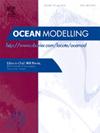An assessment of seawater desalination impact on salinities in the Arabian / Persian Gulf using a 3D circulation model
IF 2.9
3区 地球科学
Q2 METEOROLOGY & ATMOSPHERIC SCIENCES
引用次数: 0
Abstract
The Arabian / Persian Gulf, hereinafter referred to as the Gulf, is one of the major sources of freshwater through desalination in Kuwait, Bahrain, Qatar, the United Arab Emirates, the eastern Kingdom of Saudi Arabia (KSA), as well as in the coastal regions of the Iranian provinces Bushehr and Hormozgan, and the Oman governorate Musandam. Over the past four decades, the seawater desalination capacities in these states have been steadily growing. By 2023 the total production capacity has reached 25.6 Mm3/day, more than double that in 2006 (∼12.1 Mm3/day), and it is expected to add at least 6.2 Mm3/day by 2030. However, not only the Gulf serves as a source of freshwater for domestic, agricultural and industrial use, but also as a sink for the reject brine. Being a semi-enclosed water body characterized by relatively high evaporation rates of 1.5 – 2 m/year on average, small and reportedly declining river inflows, and negligible precipitations, the Gulf may eventually become impacted by anthropogenic changes in salinities, raising concerns about acceptable freshwater production rates and the overall resilience of its ecosystem. In this study, to estimate a combined impact of the desalination facilities on salinities on global and local scales, a 3D high-resolution free-surface baroclinic model of the Gulf's hydrodynamics was established using the open-source unstructured-grid Semi-implicit Cross-scale Hydroscience Integrated System Model. The horizontal resolution of the numerical mesh varied from approximately 4 km in the Sea of Oman to higher than a hundred meters in some coastal areas of the Gulf, which is notably higher than in previous studies, with the vertical resolution of up to 64 local-sigma-coordinate levels. The desalination capacities of 738 coastal plants were considered based on the 35th Worldwide Desalting Inventory of 2023. Two simulations were carried out over 3 years to assess their impact: one without the effect of the plants (baseline), and the other one with the effect of the plants. The baseline model was validated against field measurements. The volume, near-surface and near-bed averaged salinity impacts in the whole Gulf were found converging to 0.03, 0.04, and 0.05 g/l, respectively. Higher salinity increments were modeled closer to the plants, in some cases at considerable distances. For example, the impact on the median salinities at the seabed was estimated to exceed 0.1 g/l as far as 50 km away from Jubail in KSA, and Al Abu Fontas and Umm Al Houl in Qatar. Even higher increments were modeled in poorly flushed zones, such as ∼0.3 g/l in the whole Gulf of Salwa, and in the range of 0.1 – 0.5 g/l in most of the Abu Dhabi canals. Although such salinity impacts are unlikely to pose environmental threats in the present, the effect of desalination may become more profound in the future, especially in view that salinities in the Gulf have remained quasi-equilibrium over the past century, whilst the freshwater production capacity has already become comparable to ∼2.5% of the annual mean freshwater loss due to evaporation, and it continues to grow.

利用三维环流模型评估阿拉伯/波斯湾海水淡化对盐度的影响
阿拉伯/波斯湾(以下简称海湾)是科威特、巴林、卡塔尔、阿拉伯联合酋长国、沙特阿拉伯东部王国(沙特阿拉伯)以及伊朗布什尔省和霍尔木兹甘省沿海地区和阿曼穆桑达姆省通过海水淡化获得淡水的主要来源之一。在过去的四十年里,这些州的海水淡化能力一直在稳步增长。到2023年,总生产能力将达到25.6 Mm3/天,是2006年(~ 1210 Mm3/天)的两倍多,预计到2030年将至少增加620 Mm3/天。然而,墨西哥湾不仅是家庭、农业和工业使用的淡水来源,而且还是废弃盐水的水槽。海湾是一个半封闭的水体,其特点是蒸发率相对较高,平均每年为1.5 - 2米,河流流入较小且据报在减少,降水可以忽略不计,最终可能受到人为盐度变化的影响,引起人们对可接受的淡水产量及其生态系统整体恢复能力的关注。在本研究中,为了评估海水淡化设施在全球和局部尺度上对盐度的综合影响,使用开源的非结构网格半隐式跨尺度水文科学集成系统模型建立了海湾水动力学的三维高分辨率自由表面斜压模型。数值网格的水平分辨率从阿曼海的约4公里到海湾部分沿海地区的100米以上,明显高于以往的研究,垂直分辨率可达64个local-sigma坐标水平。738家沿海工厂的海水淡化能力是根据2023年第35次全球海水淡化库存来考虑的。在3年的时间里进行了两次模拟来评估它们的影响:一次没有植物的影响(基线),另一次有植物的影响。根据现场测量结果验证了基线模型。整个海湾的体积、近地表和近床平均盐度影响分别趋近于0.03、0.04和0.05 g/l。较高的盐度增量是在离植物更近的地方模拟的,在某些情况下,距离相当远。例如,据估计,在距离沙特阿拉伯的朱拜勒和卡塔尔的Al Abu Fontas和Umm Al Houl 50公里远的地方,对海底中位盐度的影响超过了0.1克/升。在较差冲洗区模拟的增量甚至更高,例如在整个萨尔瓦湾为~ 0.3 g/l,在大多数阿布扎比运河为0.1 - 0.5 g/l。虽然这种盐度影响目前不太可能构成环境威胁,但海水淡化的影响在未来可能会变得更加深远,特别是考虑到海湾的盐度在过去一个世纪中保持了准平衡,而淡水生产能力已经达到了由于蒸发而导致的年平均淡水损失的2.5%,而且还在继续增长。
本文章由计算机程序翻译,如有差异,请以英文原文为准。
求助全文
约1分钟内获得全文
求助全文
来源期刊

Ocean Modelling
地学-海洋学
CiteScore
5.50
自引率
9.40%
发文量
86
审稿时长
19.6 weeks
期刊介绍:
The main objective of Ocean Modelling is to provide rapid communication between those interested in ocean modelling, whether through direct observation, or through analytical, numerical or laboratory models, and including interactions between physical and biogeochemical or biological phenomena. Because of the intimate links between ocean and atmosphere, involvement of scientists interested in influences of either medium on the other is welcome. The journal has a wide scope and includes ocean-atmosphere interaction in various forms as well as pure ocean results. In addition to primary peer-reviewed papers, the journal provides review papers, preliminary communications, and discussions.
 求助内容:
求助内容: 应助结果提醒方式:
应助结果提醒方式:


